William Austin Burt
William Austin Burt (June 13, 1792 – August 18, 1858) was an American scientist, inventor, legislator, millwright, justice of the peace, school inspector, postmaster, judge, builder, businessman and surveyor.
William Austin Burt | |
|---|---|
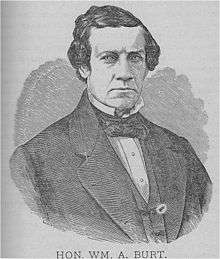 sketch, before 1873 | |
| Born | William Austin Burt June 13, 1792 |
| Died | August 18, 1858 (aged 66) Detroit, Michigan |
| Resting place | Elmwood Cemetery (Detroit, Michigan) |
| Nationality | American |
| Occupation | surveyor |
| Employer | United States government |
| Known for | inventor government surveyor |
| Title | Hon. Wm. A. Burt |
| Political party | Jeffersonian Republican |
| Spouse(s) | Phoebe Cole |
| Children | 5 boys |
He first was a builder of sawmills, but his main interest was that of surveying. He built sawmills in an area that is now the city of Port Huron, Michigan.
He built an excellent reputation for his accurate surveying work on public lands.
He surveyed boundaries in the states of Michigan, Wisconsin, Minnesota, and Iowa.
He involved his five sons in surveying and each became government surveyors.
He was also a promoter of the construction of the Sault Ste. Marie Canal, a shipping navigational lock to bypass the rapids on the St. Marys River.
As an inventor he was involved with a typewriter,
a solar compass for surveying,
and an equatorial sextant for navigation.
Biography
Ancestry
| Burt family tree showing relationships and the complete American family line of the Burts from the progenitor | ||||||||||||||||||||||||||||||||||||||||||||||||||||||||||||||||||||||||||||||||||||||||||||||||||||||||||||||||||||||||||||||||||||||||||||||||||||||||||||||||||||||||||||||||||||||||||||||||||||||||||||||||||||||||||||||||||||||||||||||||||||||||||||||||||||||||||||||||||||||||||||||||||||||||||||||||||||||||||||||||||||||||||||||||||||||||||||||||||||||||||||||||||||||||||||||||||||||||||||||||
|---|---|---|---|---|---|---|---|---|---|---|---|---|---|---|---|---|---|---|---|---|---|---|---|---|---|---|---|---|---|---|---|---|---|---|---|---|---|---|---|---|---|---|---|---|---|---|---|---|---|---|---|---|---|---|---|---|---|---|---|---|---|---|---|---|---|---|---|---|---|---|---|---|---|---|---|---|---|---|---|---|---|---|---|---|---|---|---|---|---|---|---|---|---|---|---|---|---|---|---|---|---|---|---|---|---|---|---|---|---|---|---|---|---|---|---|---|---|---|---|---|---|---|---|---|---|---|---|---|---|---|---|---|---|---|---|---|---|---|---|---|---|---|---|---|---|---|---|---|---|---|---|---|---|---|---|---|---|---|---|---|---|---|---|---|---|---|---|---|---|---|---|---|---|---|---|---|---|---|---|---|---|---|---|---|---|---|---|---|---|---|---|---|---|---|---|---|---|---|---|---|---|---|---|---|---|---|---|---|---|---|---|---|---|---|---|---|---|---|---|---|---|---|---|---|---|---|---|---|---|---|---|---|---|---|---|---|---|---|---|---|---|---|---|---|---|---|---|---|---|---|---|---|---|---|---|---|---|---|---|---|---|---|---|---|---|---|---|---|---|---|---|---|---|---|---|---|---|---|---|---|---|---|---|---|---|---|---|---|---|---|---|---|---|---|---|---|---|---|---|---|---|---|---|---|---|---|---|---|---|---|---|---|---|---|---|---|---|---|---|---|---|---|---|---|---|---|---|---|---|---|---|---|---|---|---|---|---|---|---|---|---|---|---|---|---|---|---|---|---|---|---|---|---|---|---|---|---|---|---|---|---|---|---|---|---|---|---|---|---|---|---|---|---|---|---|---|---|---|---|---|---|---|---|---|---|---|---|---|---|---|---|---|---|---|---|---|---|---|---|---|
| ||||||||||||||||||||||||||||||||||||||||||||||||||||||||||||||||||||||||||||||||||||||||||||||||||||||||||||||||||||||||||||||||||||||||||||||||||||||||||||||||||||||||||||||||||||||||||||||||||||||||||||||||||||||||||||||||||||||||||||||||||||||||||||||||||||||||||||||||||||||||||||||||||||||||||||||||||||||||||||||||||||||||||||||||||||||||||||||||||||||||||||||||||||||||||||||||||||||||||||||||
Early life
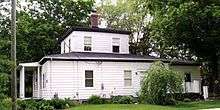
in Washington Township, Michigan
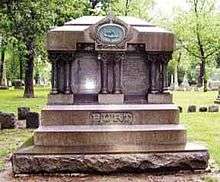
Burt's parents were Alvin Burt and Wealthy (Austin) Burt of Worcester, Massachusetts. He was born June 13, 1792, at his parents farm located in nearby Petersham, Massachusetts.[3] Burt was the fifth of eight children and of Scottish and English ancestry.[4] During his childhood Burt received a total of six weeks of formal schooling in the local public schools.[5] His European progenitor, Richard Burt, immigrated to America in 1638 and settled in Taunton, Massachusetts.[6]
Burt's parents sold their family farm in 1802 because of poor economic times and moved to Freehold, New York.[7] In 1803 the family moved to the town of Broadalbin, New York. He was greatly influenced by his mother's virtues.[8]
Burt was about fourteen his father sent him to the district school for a total of three weeks to begin studies in geometry, surveying, and navigation from a Scottish teacher.[9] He did well at that and at any leisure moments he pursued the studies on his own. About this time his father gave him a book on navigation that was published in 1779. Burt showed much interest in this and was inspired to someday become a master of a boat. He motivated himself to learn the traverse table and the method of determining latitude. He developed mechanical skills which enabled him to construct a quadrant instrument. With this he determined the latitude of his father's house with a pretty good degree of accuracy, even though he had never seen a nautical instrument before. He was also interested in astronomy and studied almanacs and navigation.[10][8]
From about the age of fifteen he determined his calling to be such as would be useful to mankind. He studied mathematics, natural philosophy, and astronomy whenever he could borrow books. He was from there on interested in these scientific and mathematical subjects his entire life. When Burt was about sixteen, his father sent him to school for six weeks to learn science and mathematics, which he continued on his own, even though his duties at home and on the farm were equal to other boys in his age group. Burt recalled this as he wrote about himself when he was sixty-two years old.[8]
Mid life
Burt's mother Wealthy lost her father, William Austin, at sea. She therefore discouraged him from becoming master of a ship. Burt decided then to apply his science and mathematical knowledge and bought a broken surveying compass when he was eighteen years old in 1810 to see what he could do with it.[11] He repaired it and surveyed the vicinity of his father's home which was near East Aurora in Erie County, New York.[8] In 1812, he enlisted in the United States army, which interrupted his surveying work for a while.[10]
Burt then after the War of 1812 lived in Wales Center of Erie County. He held several public offices while there, with some being: justice of the peace, school inspector, postmaster, and county surveyor. In 1817, at the age of twenty-five, Burt did some traveling. He went on his journeys mostly on foot, but some parts he had to use small boats or horses. His travels took him from his home to the cities of Pittsburgh, Cincinnati, and St. Louis. He eventually took a northerly route by horse through Illinois and Indiana to Detroit, then by boat to Buffalo. These travels were preparatory to the time when he hoped to become a United States deputy surveyor. Meanwhile, his career was the trade of a millwright in the state of New York.[8]
Burt, at the age of 32 in 1824, moved to Michigan from where he lived in Massachusetts. He came into the acquaintance of influential prominent men who urged him to settle in the city of Detroit. There he lived and worked until the following year. He then traveled up the St. Clair River in 1825 to an area that is now the city of Port Huron. There he built a sawmill on the Black River for businessman Robert Smart. Smart named the sawmill Clyde Mills after the River Clyde of his native Scotland. In 1827, Connecticut-born Detroit merchant Ralph Wadhams bought the sawmill from Smart and later in 1829 moved there from Detroit. This was when Smart, together with Wadhams and Detroit politician John Biddle became interested in the pine lands of St. Clair County to exploit them.[12] The sawmill ultimately became a significant business of the district and in time it became known as Wadhams Mill since Ralph Wadhams spent the remainder of his life living there - 48 years.[13]
Burt preferred the country life for his wife and sons. When he was forty-one years of age he was appointed United States deputy surveyor. At that time in 1833 three sons, John, Alvin and Austin, were old enough to work as assistant surveyors to learn the trade. In the next eighteen years, all five of his sons became United States deputy surveyors. He trained scores of other boys in surveying techniques at Mount Vernon, in Macomb County, Michigan. Burt was also a trainer of surveying techniques in the states of Wisconsin and Iowa.[8]
Burt spent two surveying seasons in Iowa, during 1836–37 and 1842–43. There he ran the course of the fifth principal meridian in Iowa. Burt used his solar compass for the first time in 1836. Alvin, one of his sons, surveyed the boundary line between Iowa and Minnesota with this same instrument. He also surveyed Township and Range lines in Wisconsin from 1840 to 1842, where his five sons also worked.[14] Wisconsin and Michigan disputed over boundary lines, so to settle the matter Burt was selected to make a re-survey of the interstate boundary. He was the first United States linear surveyor in the Upper Peninsula of Michigan.[8]
Burt took over the geological notes of Dr. Douglass Houghton after his death in 1845 and completed the work in the Upper Peninsula of Michigan. The United States government accepted his work as satisfactory. Burt became prominent, not only in Michigan, but in the nation generally. He had an excellent reputation because of his surveying achievements. While surveying, he won acclaim for his accurate work on public land surveys. He worked hard for the building of the Sault Ste. Marie Canal and helped in making the preliminary survey of it.[15]
Personal life
Burt in 1812 became acquainted with Phoebe Cole of Wales Center, New York. She was the daughter of John Cole, a prominent citizen of the state of New York. He married her on July 4, 1813 when he was twenty-one years old.[16] They had five boys, John (1814-1886), Alvin (1816-1846), Austin (1818-1894), Wells (1820-1887), and William (1825-1898).
Burt was a member of the Michigan Legislature and is credited with contributing the legislation for building the Sault Ste. Marie Canal. It is a set of navigational water locks for ships and boats traveling between Canada and the United States. The locks are part of the shipping route from the Atlantic Ocean to Lake Superior by way of upper Michigan.
Burt was a Jeffersonian Democrat, but did not actively participate in national political affairs. He was a member of the Michigan Territorial Council, 1826–1827. He served as Mount Vernon's (Michigan) first postmaster from 1832 to 1856. He was a Macomb County Circuit Court judge in 1833, a state legislator in 1853, and a deputy U.S. surveyor from 1833 to 1853.[17] Burt was a member of the Masonic fraternity, participating as one of the founders and the first Master of the third Masonic lodge organized in Michigan. Burt was appointed as Judge of a Michigan Territorial Court, so from then on was referred to as "Judge Burt."[18]
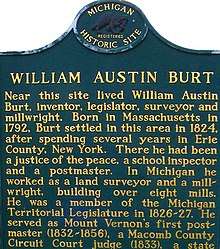
Later life and death
Burt moved from Mount Vernon, Michigan to Detroit in 1857. He died there on August 18, 1858[19] at age 66 while giving instructions to a class of sea captains on how to use the equatorial sextant, a navigational instrument he invented.[3] His remains are interred in the Burt Family lot at the Elmwood Cemetery.[20] The National Shorthand Association, at Detroit on August 22, 1919, unanimously voted to place a wreath on the monument over the Burt family grave in Elmwood Cemetery, honoring him as "The inventor of the first writing machine."[21]
Legacy
Burt is commemorated at Stony Creek, near his home in Mt. Vernon, Michigan, by a historical plaque.[22] Burt Lake in Cheboygan County, Michigan, is named after him, as is Burt Township, Cheboygan County, Michigan.[23] The New York Shorthand Reporters' Association nominated him as inventor of the typewriter in the Hall of Fame of New York University.[24][25] The University of Michigan received Burt's original 1858 Equatorial Sextant from his heirs in 1909 as an heirloom to navigation and engineering.[26]
Inventions
Burt made several inventions. He was the inventor, maker and patentee of the first typewriter constructed in America.[27][28][29] Among many prospects he is referred to as the "father of the typewriter" by journals and magazines.[30][31][32] Burt also invented the first workable solar compass, a solar use surveying instrument, and the equatorial sextant - a precision navigational aid to determine with one observation the location of a ship out at sea.[33]
Typographer
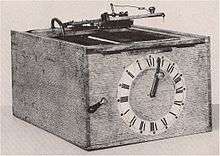
The 1829 patented typographer was a predecessor to the modern-day typewriter.[34] The "typographer" was the first constructed and operating type-writing machine anywhere according to the patent.[28] Burt did research for an appropriate name for his invention and settled with "typographer" which ultimately became the hyphened word "type-writer" in 1874. This was its name until the hyphen was removed in 1919, becoming then just typewriter.[3]
The typographer consisted of a wooden box with a swinging lever on one end for impressing. The typeface letters were mounted on a short sector attached on the underside of the lever. Pressing down imprinted the letter selected on the paper. When a page was full it was torn off like a paper towel, as the paper was on a large continuous roll. One could print both upper and lower case letters. The first writing machine Burt built did not live up to his expectation, so he built an improved version six months later that wasn't much faster. The improvements were mostly in looks and appearance for marketing the machine to investors. While Burt's typographer generated a lot of interest and did a very good job of typing clear and neat letters it did not become a commercial success. The typographer was "born out of season"[35] and was before its time, so no market was found for the device or his patent during his lifetime.[36]
Austin Burt, the great grandson of the inventor, built a working model of the typographer for the 1893 Chicago's World's Fair working from a parchment copy of the original patent (USX 558111).[3] He explained in a letter dated April 1, 1893, that was attached to the model that it took him a month to construct it from the original patent description because many of the parts had to be hand-made. It was on display and a picture taken of it at the University of Minnesota just prior to going to the Chicago's World's Fair in the middle of April. The younger Austin then was a student of engineering at the University.[28]
The replica built by Austin was returned to the model room of the Patent Office in Washington D.C. when the Chicago's World's Fair closed. There it remained until 1903 when the Patent Office model room was closed. The "typographer" was then shipped in 1903 to Hiram A. Burt of Marquette, Michigan. Burt's machine and the original Letters Patent went to Hiram's daughter, Mrs. Howard Corning, of Bangor, Maine when Hiram moved to Maine at a later date. The replica as of 1922 was in the Smithsonian Institution and the documents of the original Letters Patent stayed in the family of Mrs. Howard Corning.[21]

Solar compass
While Burt invented the typographer, he is better known for his solar compass, invented in 1835.[29] The reason is that his surveyor's precision instrument solved many problems encountered by surveyors in the ordinary use of the magnetic compass for surveying. Burt was an active surveyor in Michigan, Wisconsin, Iowa and other states. He was the leader of many survey teams in Michigan, when the state was just a wilderness. His solar compass and adaptations of it became standard instruments for the government land survey in much of the western United States and were used until the Global Positioning System was available in the late 20th century. Burt devised the solar compass so that garbled readings caused by the Earth's magnetic field would be cleared up and so that north–south survey lines could be easier to find.[37][38]
Burt discovered the Marquette Iron Range in Marquette County of the Upper Peninsula of Michigan in 1844.[39] He noted that the needle of a magnetic compass would spin unusually violently in some locations in the vicinity of Marquette County. Burt persevered in his survey of Michigan's Upper Peninsula, however, using his solar compass when he realized the normal magnetic compass would not furnish accurate readings owing to the large deposits of minerals in the area. His solar compass invention had much better accuracy in such situations. The solar compass eventually become the standard tool and was adopted by the General Land office to be used on all federal surveys, noted for its usefulness in areas of magnetic disturbance. Burt's surveying tool was used in the Michigan Survey and employed in regions that had an abundance of iron ore minerals which would interfere with accurate readings when using ordinary instruments.[40] The demand for his surveying precision instrument rose dramatically. Congress would not renew Burt's patent in 1850 when it expired. He claimed that he didn't even receive $300 for his right in the invention.[41]
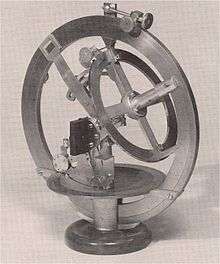
Equatorial sextant
Burt designed and invented the Equatorial Sextant for the purpose of getting accurate bearings and positions of ships at sea.[5] When the instrument was properly manipulated it was capable of reading a ship's azimuths, altitude, time and declination with one observation. Burt applied the principles of his earlier Solar Compass to make this precision navigational aid that used the sun as a reference point. Other compasses of the time relied on the earth's north magnetic pole and were not reliable, causing ships to go off course. Burt's sextant was not affected by magnetism or iron ore deposits, and hence, the new sextant directed ships at sea much more true to course.[42]
References
- Burt 1893, p. 513.
- Burt 1893, p. 516.
- "Replica of First Typewriter in Hands of Austin Burt, Descendant of Maker". The Courier. Waterloo, Iowa. June 17, 1922. p. 5 – via Newspapers.com

- "Relatives of Alvin Burt". Ancestry.com. Retrieved June 25, 2020.
- Cannon, George H. (1920). "The life and times of William A. Burt". Michigan Historical Collections. 5: 115–123. Retrieved June 11, 2020.
- White 1922, p. 367.
- "William Austin Burt". Historical Collections. 28: 644–647. 1900. Retrieved June 12, 2020.
- Fuller, pp. 175-193 William Austin Burt- inventor, by Horace Eldon Burt (Chicago) biography
- Cox, John A. (August 9, 1953). "Patron Saint of Stenographers". Hartford Courant. Hartford, Connecticut. p. 112 – via Newspapers.com

- White, pp. 367-368
- "The inventor of the typewriter may find a niche in the Hall of Fame". The Kansas City Times. Kansas City, Missouri. September 11, 1931. p. 18 – via Newspapers.com

- "Typewriter Inventor Pioneered Here". The Times Herald. Port Huron, Michigan. April 5, 1964. p. 8 – via Newspapers.com

- "Wadhams - Region's fastest-growing commercial center attributes success to location". The Times Herald. Port Huron, Michigan. March 28, 1999. p. 145 – via Newspapers.com

- "Early Land Surveyors left their marks". The Wakefield News. Wakefield, Michigan. March 25, 1976. p. 4 – via Newspapers.com

- Burt 1920, p. 7.
- Tuttle 1873, p. 514.
- Tuttle 1873, p. 516.
- Burt 1920, p. 9.
- Tuttle 1873, p. 523.
- Fuller 1922, p. 180.
- Fuller 1922, p. 191.
- William Austin Burt Historical Marker
- Hannan, p. 195
- "Nominated for Hall of Fame". The Courier. Waterloo, Iowa. June 17, 1922. p. 5 – via Newspapers.com

- Staff (1920). "This Year's Nominations for the Hall of Fame". Scientific American. 123: 226. Retrieved May 14, 2020.
- Staff (1916). "Equatorial Sextant". The Michigan Technic. 29: 201. Retrieved June 11, 2020.
- Fuller 1922, p. 188.
- Kidder, p. 12
- Vrooman, p. 18-20
- Kidder, p. 11
- Annual report of the American Historical Association, Volume 1, page 121
- Michigan History Magazine(1922), Volume 6, page 180
- Historical record of the Michigan Daughters of the American Revolution, 1893-1930, Volume 1
- Martin, p. 47
- Dykema, Frank L. (1922). "A record of the development of the Grand Rapids americanization society's plan of citizenship training through the ballot". Michigan History Magazine. 6 (4): 181. Retrieved May 14, 2020.
- Adler, pp. 59–60
- "Solar Compass". Smithsonian Institution.
- "Burt's Solar Compass". Wisconsin Historical Society.
- "Survey traces are uncovered". The Escanaba Daily Press. Escanaba, Michigan. March 9, 1976. p. 3 – via Newspapers.com

- Tuttle 1873, p. 520.
- Solar Compass
- "Smithsonian - Equatorial Sextant". Archived from the original on 2011-06-29. Retrieved 2010-11-10.
Sources
- Adler, Michael H., The Writing Machine, A History of the Typewriter George Allen & Unwin Ltd, 1973 ISBN 0-04-652004-X
- Burt, Henry Martyn (1893). Early Days in New England. C. W. Bryan Company.
- Burt, Horace Eldon (1920). William Austin Burt, inventor of the typewriter first constructed in any country, solar compass, equatorial sextant. R.R. Donnelley & sons Company. OCLC 29418708.
- Burt, John S., They Left Their Mark, William Austin Burt and Sons, Surveyors of Public Domain, Rancho Cordova, CA., Landmark Enterprises, 1985 ISBN 091084531X
- Burt, William A., A key to Burt's solar compass and surveyor's companion, William S. Young, 1858 OCLC 1136661697
- Fuller, George Newman (1922). Michigan history, Volume 6. Michigan Department of State. OCLC 983255566.
- Hannan, Caryn, Michigan Encyclopedia, State History Publications, 2008 ISBN 1878592947
- Kidder, Harry M., Transactions of the New York State Shorthand Reporters on December 28, 1920, Boyd Printing Co., Inc., Albany, N. Y., 1921 OCLC 7772514
- Martin, John Bartlow, Call It North Country: The Story of Upper Michigan, Wayne State University Press, 1986. ISBN 0-8143-1869-X
- Tuttle, Charles Richard (1873). General History of Michigan with biographical sketches. R. D. S. Tyler & Company. OCLC 646929780.
- Vrooman, John Wright;The Story of the Typewriter, 1873-1923;Press of A. H. Kellogg Company; 1923 OCLC 936927259
- White, James T. (1922). Cyclopedia of American Biography, Volume 18. J. T. White. OCLC 164589128.CS1 maint: ref=harv (link)
External links

- Burt's work in the Iron range
- MSU biographical information